How Much Does A Bar Weigh is a common question for anyone involved in weightlifting, powerlifting, or even just starting out at the gym, and understanding the weight of different barbells is crucial for tracking progress and ensuring safety. At HOW.EDU.VN, we provide expert guidance to help you navigate the world of fitness and strength training with confidence, offering solutions for all your fitness-related queries. Discover essential insights into barbell weights, variations, and their impact on your training regimen, complete with valuable information on Olympic bars, standard bars, and specialty bars, enhancing your fitness journey with accurate measurements.
1. Understanding the Basics of Barbell Weight
Knowing the weight of a barbell is fundamental for anyone serious about strength training. It’s not just about adding plates; it’s about understanding the total load you’re lifting.
1.1. Why Knowing Barbell Weight Matters
Accurate weight tracking is essential for monitoring progress, setting realistic goals, and preventing injuries. Ignoring the bar’s weight can lead to miscalculations and potentially unsafe lifting practices.
1.2. The Standard Olympic Barbell Weight
The most common barbell you’ll encounter is the Olympic barbell, typically found in most gyms. These bars are designed to meet specific standards for weight and dimensions.
1.3. Quick Guide to Common Barbell Weights
| Barbell Type | Weight | Length | Diameter |
|---|---|---|---|
| Men’s Olympic | 45 lbs (20 kg) | 7.2 feet (2.2 m) | 28 mm |
| Women’s Olympic | 33 lbs (15 kg) | 6.6 feet (2.01 m) | 25 mm |
| Standard Barbell | 12.8-15 lbs (5.8-6.8 kg) | 5-6 feet | 1 inch |
| Safety Squat Bar | 60-75 lbs (27-34 kg) | Varies | Varies |
| Hex Bar/Trap Bar | 54 lbs (25 kg) | Varies | Varies |
| Multi-Grip Bar | 35-45 lbs | Varies | Varies |
| Tricep Bar | 22 lbs (10 kg) | Varies | Varies |
| EZ Bar | 22 lbs (10 kg) | Varies | Varies |

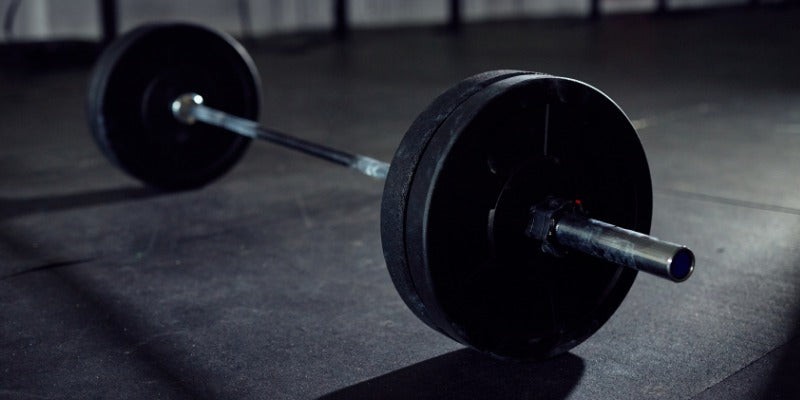
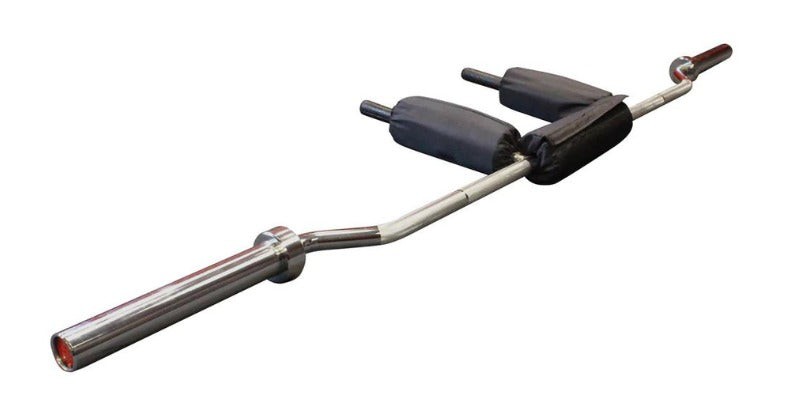
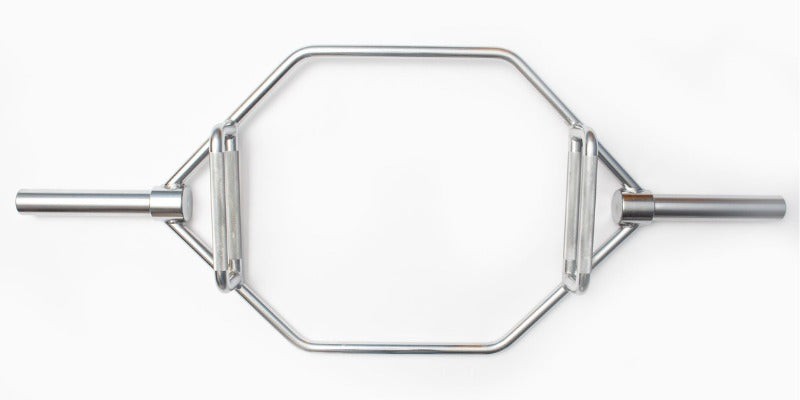

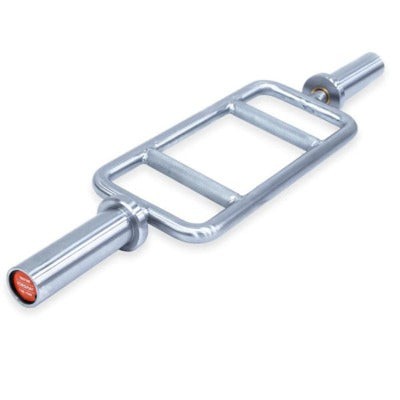
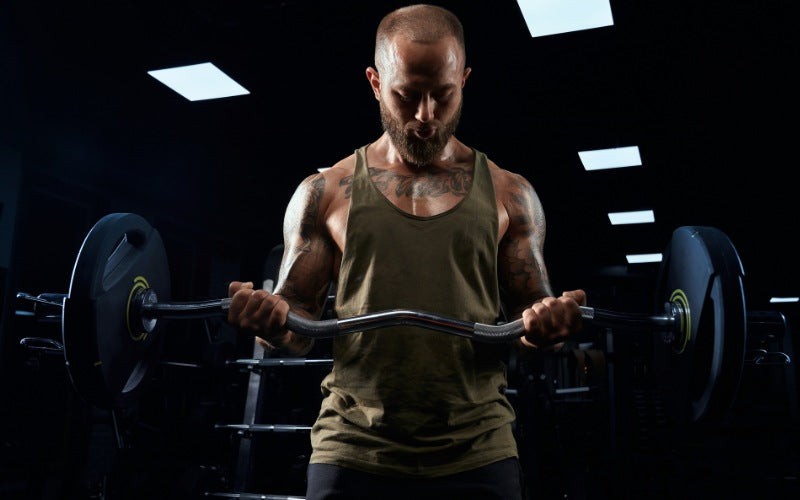
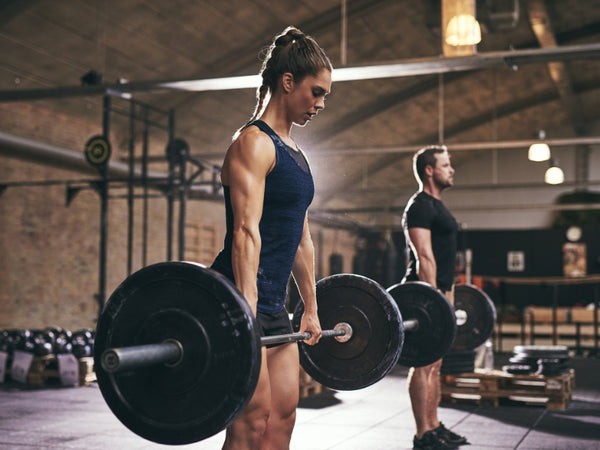
2. Different Types of Barbells and Their Weights
The world of barbells is diverse, with each type designed for specific exercises and training styles. Let’s explore the most common types and their respective weights.
2.1. Standard Barbell Weight (1″ Spinlock)
Standard barbells are typically found in home gyms and body pump classes. They have a 1″ diameter and are designed for weight plates with a 1″ hole.
- Weight: 5ft bar = 12.8lbs (5.8kg), 6ft bar = 15lbs (6.8kg)
- Features: Often have threaded ends with spinlock collars to secure weight plates.
- Common Uses: Light to moderate weightlifting, home workouts, and group fitness classes.
2.2. Olympic Barbell Weight
Olympic barbells are the standard in commercial gyms and are used in Olympic and powerlifting competitions.
- Weight: 45lbs (20kg) for men’s, 33lbs (15kg) for women’s
- Length: 7.2 feet (2.2m) for men’s, 6.6 feet (2.01m) for women’s
- Features: 2″ diameter sleeves that rotate, allowing for Olympic-style lifts like snatches and clean-and-jerks.
- Common Uses: Squats, deadlifts, bench presses, overhead presses, and Olympic lifting.
2.3. Safety Squat Bar Weight
Safety squat bars are designed to alleviate shoulder stress and provide a different squatting experience.
- Weight: 60 to 75 pounds (27kg to 34kg)
- Features: Padded shoulder rests and handles that extend in front of the shoulders.
- Common Uses: Squats, especially for individuals with shoulder mobility issues or those looking to vary their squat routine.
2.4. Trap Bar/ Hex Bar Weight
The hex bar, also known as a trap bar or shrug bar, is shaped like a hexagon and allows you to stand in the center while lifting.
- Weight: Approximately 54lbs (25kg)
- Features: Neutral grip handles, which reduce stress on the grip and lower back.
- Common Uses: Deadlifts, shrugs, and farmer’s walks.
2.5. The Multi-Grip Bar
The multi-grip bar, often called a Swiss bar, has multiple grip options, allowing for varied hand positions.
- Weight: Ranges from 35 to 45 pounds
- Features: Parallel grip options that can reduce stress on the wrists and shoulders.
- Common Uses: Bench presses, overhead presses, and rows.
2.6. Tricep Bar Weight
The tricep bar is designed specifically for triceps exercises.
- Weight: Typically weighs 22lbs (10kg)
- Features: Allows for different grip positions to target the triceps effectively.
- Common Uses: Skull-crushers and other triceps extensions.
2.7. EZ Bar Weight
The EZ bar features a W shape in the middle, providing a more natural grip position for the wrists and arms.
- Weight: Usually around 22lbs (10kg), but can vary between 20 and 40 pounds.
- Features: Ergonomic design that reduces wrist strain.
- Common Uses: Bicep curls, skull-crushers, and tricep extensions.
3. Men’s vs Women’s Olympic Barbells
Olympic barbells come in different sizes and weights for men and women, adhering to the standards set by Olympic and powerlifting federations.
3.1. Key Differences
- Men’s Olympic Barbell: 7.2 ft long (2.2m), 28mm grip diameter, 45lbs (20kg).
- Women’s Olympic Barbell: 6.6ft long (2.01m), 25mm grip diameter, 33lbs (15kg).
3.2. Why the Difference?
The differences in size and weight are designed to accommodate the average body size and strength levels of men and women, ensuring safety and optimal performance.
4. The Importance of Counting Barbell Weight
It’s crucial to include the barbell’s weight when tracking your lifts. Ignoring it can lead to inaccurate progress monitoring and potential overestimation of strength gains.
4.1. Accurate Tracking
Always factor in the barbell’s weight to accurately assess your strength and progression. This ensures you’re setting realistic goals and avoiding potential injuries.
4.2. Example Scenario
If you have two 45-pound plates on each side of a standard 45-pound Olympic barbell, the total weight you’re lifting is 135 pounds (45 + 45 + 45), not just 90 pounds.
5. Accounting for Clips and Plates
Don’t forget to consider the weight of clips and plates. While they may seem insignificant, they can add up and affect the accuracy of your lifts.
5.1. Plate Variations
Plates come in various weights, including 2.5, 5, 10, 15, 25, 35, 45, and even 55 pounds. Choose the appropriate plates to incrementally increase your lifts.
5.2. The Role of Clips/Collars
Clips or collars secure the plates on the barbell and can weigh up to 1 pound each. While this may not seem like much, it’s still a factor to consider for precise weight measurements.
6. Finding the Right Barbell at Your Gym
Most commercial gyms, like LA Fitness or Planet Fitness, typically have men’s Olympic barbells that are 7.2 feet long and weigh 45 pounds (20kg). However, it’s always a good idea to confirm the weight with gym staff.
6.1. Verifying Barbell Weight
If you’re unsure about the weight of a barbell, ask a gym employee to confirm. This ensures you’re accurately tracking your lifts and avoiding any miscalculations.
6.2. Gym Standards
Most gyms adhere to standard weightlifting equipment guidelines. Olympic barbells are a staple, but it’s always best to double-check if you’re unsure.
7. Maximizing Your Training with Expert Advice from HOW.EDU.VN
Navigating the world of fitness and strength training can be complex, but with expert guidance from HOW.EDU.VN, you can achieve your goals with confidence.
7.1. Personalized Training Plans
Our team of experienced fitness professionals can create personalized training plans tailored to your specific needs and goals. Whether you’re a beginner or an advanced lifter, we can help you optimize your workouts and track your progress effectively.
7.2. Expert Guidance on Equipment
Understanding the equipment you’re using is crucial for safety and effectiveness. At HOW.EDU.VN, we provide detailed information and expert advice on various types of barbells, weights, and other fitness equipment to help you make informed decisions.
7.3. Injury Prevention Strategies
Preventing injuries is a top priority in any fitness program. Our experts offer practical strategies to minimize the risk of injuries, including proper warm-up techniques, form correction, and progressive overload principles.
8. How HOW.EDU.VN Can Help You Achieve Your Fitness Goals
At HOW.EDU.VN, we connect you with over 100 world-renowned Ph.D.s and experts who can provide personalized guidance to help you achieve your fitness goals.
8.1. Access to Top Experts
Our platform gives you direct access to leading experts in various fields, including fitness, nutrition, and sports science. These experts can provide tailored advice to help you optimize your training, nutrition, and recovery.
8.2. Personalized Consultation
We offer personalized consultation services to address your specific questions and concerns. Whether you’re struggling with a particular exercise, need help with meal planning, or want to optimize your recovery, our experts can provide the guidance you need to succeed.
8.3. Cutting-Edge Information
Stay up-to-date with the latest research and trends in the fitness industry. Our experts provide evidence-based information and practical tips to help you make informed decisions and achieve your fitness goals.
9. The Benefits of Expert Guidance
Seeking expert guidance can significantly enhance your fitness journey, providing you with the knowledge, support, and accountability you need to succeed.
9.1. Customized Training Plans
Expert guidance allows for the creation of customized training plans that are tailored to your individual needs, goals, and fitness level. This ensures that you’re maximizing your efforts and achieving optimal results.
9.2. Injury Prevention
Experienced trainers and coaches can identify potential risk factors and provide strategies to prevent injuries. This can save you time, money, and frustration in the long run.
9.3. Enhanced Motivation
Having a knowledgeable and supportive expert by your side can provide the motivation you need to stay consistent and committed to your fitness goals.
10. Maximizing Your Strength Training: Tips and Strategies
To get the most out of your strength training, it’s essential to follow proven tips and strategies.
10.1. Progressive Overload
Gradually increase the weight, sets, or reps over time to challenge your muscles and promote growth. This is a fundamental principle of strength training.
10.2. Proper Form
Maintain proper form during each exercise to prevent injuries and maximize muscle activation. If you’re unsure about your form, seek guidance from a qualified trainer or coach.
10.3. Rest and Recovery
Allow your muscles adequate time to recover between workouts. Aim for 7-9 hours of sleep per night and incorporate rest days into your training schedule.
11. Integrating Nutritional Strategies for Optimal Results
Nutrition plays a crucial role in supporting your strength training efforts.
11.1. Macronutrient Balance
Ensure you’re consuming a balanced diet with adequate protein, carbohydrates, and healthy fats to fuel your workouts and support muscle growth.
11.2. Hydration
Stay hydrated by drinking plenty of water throughout the day, especially before, during, and after your workouts.
11.3. Supplementation
Consider incorporating supplements like creatine, protein powder, and BCAAs to enhance your performance and recovery.
12. The Future of Fitness: How Technology is Changing the Game
Technology is revolutionizing the fitness industry, providing new tools and resources to help you achieve your goals.
12.1. Wearable Devices
Wearable devices like fitness trackers and smartwatches can monitor your activity levels, heart rate, and sleep patterns, providing valuable insights into your overall health and fitness.
12.2. Online Training Platforms
Online training platforms offer access to a wide range of workout programs, virtual trainers, and support communities, allowing you to train from anywhere in the world.
12.3. Virtual Reality Fitness
Virtual reality fitness is an emerging trend that combines gaming and exercise, providing immersive and engaging workout experiences.
13. Case Studies: Success Stories from HOW.EDU.VN
Discover how individuals have transformed their fitness journeys with the expert guidance and support of HOW.EDU.VN.
13.1. Case Study 1: Weight Loss Transformation
John, a 45-year-old professional, lost 50 pounds and significantly improved his overall health with a personalized training and nutrition plan from a HOW.EDU.VN expert.
13.2. Case Study 2: Strength Gain Success
Sarah, a 30-year-old athlete, increased her squat and bench press by 30% with the guidance of a strength training specialist from HOW.EDU.VN.
13.3. Case Study 3: Injury Recovery
Mike, a 50-year-old runner, fully recovered from a knee injury and returned to running with the help of a rehabilitation expert from HOW.EDU.VN.
14. Common Mistakes to Avoid in Strength Training
Avoid these common mistakes to ensure you’re maximizing your results and minimizing your risk of injury.
14.1. Lifting Too Much Too Soon
Progress gradually and avoid lifting weights that are too heavy for your current strength level.
14.2. Neglecting Proper Form
Always prioritize proper form over lifting heavy weights.
14.3. Ignoring Rest and Recovery
Give your body adequate time to rest and recover between workouts.
15. The Psychological Aspects of Strength Training
Strength training is not just about physical strength; it also has significant psychological benefits.
15.1. Improved Mood
Exercise releases endorphins, which have mood-boosting effects.
15.2. Increased Confidence
Achieving your fitness goals can boost your self-esteem and confidence.
15.3. Stress Reduction
Strength training can be an effective way to reduce stress and anxiety.
16. How to Choose the Right Barbell for Your Needs
Selecting the right barbell depends on your training goals, experience level, and personal preferences.
16.1. Consider Your Training Goals
Are you focused on Olympic lifting, powerlifting, or general fitness? Choose a barbell that aligns with your specific goals.
16.2. Evaluate Your Experience Level
Beginners may benefit from starting with a lighter barbell, while experienced lifters may prefer a heavier, more specialized bar.
16.3. Test Different Barbells
If possible, try out different barbells at your gym to see which one feels most comfortable and suits your needs.
17. The Science Behind Muscle Growth
Understanding the science behind muscle growth can help you optimize your training and nutrition strategies.
17.1. Muscle Protein Synthesis
Muscle growth occurs when the rate of muscle protein synthesis exceeds the rate of muscle protein breakdown.
17.2. Hormonal Response
Strength training can stimulate the release of hormones like testosterone and growth hormone, which promote muscle growth.
17.3. Nutrient Timing
Consuming protein and carbohydrates around your workouts can enhance muscle protein synthesis and recovery.
18. Advanced Training Techniques for Experienced Lifters
Experienced lifters can incorporate advanced training techniques to break through plateaus and maximize their results.
18.1. Periodization
Vary your training intensity and volume over time to prevent overtraining and promote continued progress.
18.2. Supersets
Perform two exercises back-to-back with minimal rest to increase workout intensity and efficiency.
18.3. Drop Sets
Perform an exercise to failure, then reduce the weight and continue for additional reps to maximize muscle fatigue.
19. Debunking Common Myths About Strength Training
Separate fact from fiction with these debunked myths about strength training.
19.1. Myth: Strength Training Will Make Women Bulky
Fact: Women do not have the same hormonal profile as men and are unlikely to develop bulky muscles from strength training.
19.2. Myth: You Need to Lift Heavy Weights to Build Muscle
Fact: You can build muscle with lighter weights and higher reps, as long as you’re training close to failure.
19.3. Myth: Cardio is the Best Way to Lose Weight
Fact: Strength training can be an effective way to lose weight and improve body composition, as it helps build muscle and increase metabolism.
20. Conclusion: Achieving Your Fitness Potential with HOW.EDU.VN
Understanding how much a bar weighs is just the beginning of your strength training journey. With the expert guidance and support of HOW.EDU.VN, you can optimize your training, nutrition, and recovery to achieve your fitness potential. Whether you’re looking to lose weight, build muscle, improve your athletic performance, or simply enhance your overall health and well-being, our team of world-renowned experts is here to help you every step of the way.
Ready to take your fitness to the next level? Contact HOW.EDU.VN today and discover the difference that expert guidance can make. Our team of over 100 Ph.D.s and leading experts is ready to provide personalized support and help you achieve your goals. Don’t let uncertainty hold you back; connect with us and experience the power of expert advice. Contact us at 456 Expertise Plaza, Consult City, CA 90210, United States. Whatsapp: +1 (310) 555-1212. Visit our website HOW.EDU.VN to learn more.
FAQ: Frequently Asked Questions About Barbell Weights and Strength Training
Q1: How much does a standard Olympic barbell weigh?
A: A standard Olympic barbell weighs 45 pounds (20 kg) for men’s bars and 33 pounds (15 kg) for women’s bars.
Q2: Why are there different weights for men’s and women’s Olympic barbells?
A: The different weights are designed to accommodate the average body size and strength levels of men and women.
Q3: Should I count the weight of the barbell when tracking my lifts?
A: Yes, always include the barbell’s weight to accurately assess your strength and progression.
Q4: How much do standard weight plates weigh?
A: Weight plates come in various sizes, including 2.5, 5, 10, 15, 25, 35, 45, and 55 pounds.
Q5: What is a safety squat bar and how much does it weigh?
A: A safety squat bar is a specialized barbell with padded shoulder rests and handles, typically weighing between 60 and 75 pounds (27-34 kg).
Q6: What is a hex bar and how much does it weigh?
A: A hex bar is a hexagon-shaped barbell that allows you to stand in the center while lifting, typically weighing around 54 pounds (25 kg).
Q7: What is an EZ bar and how much does it weigh?
A: An EZ bar is a barbell with a W shape in the middle, designed to reduce wrist strain, typically weighing around 22 pounds (10 kg).
Q8: How do I choose the right barbell for my needs?
A: Consider your training goals, experience level, and personal preferences when selecting a barbell.
Q9: What are some common mistakes to avoid in strength training?
A: Avoid lifting too much too soon, neglecting proper form, and ignoring rest and recovery.
Q10: How can HOW.EDU.VN help me achieve my fitness goals?
A: how.edu.vn connects you with over 100 world-renowned Ph.D.s and experts who can provide personalized guidance to help you optimize your training, nutrition, and recovery.
